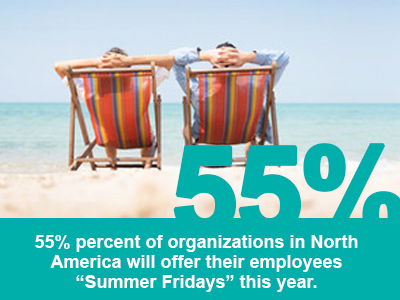
By Heather Nezich, courtesy SBAM Approved Partner ASE
55% percent of organizations in North America will offer their employees “Summer Fridays” this year, according to a survey by Gartner, Inc. This is a 9% increase from the number of North American organizations that offered Summer Fridays in 2018.
“Summer Fridays” — days that organizations offer employees the option to leave early or take the entire day off — are an example of the perks that organizations are offering to gain competitive advantage in attracting and retaining top talent. In today’s tight labor market, workers have the upper hand.
“Employers are incentivized to do everything they possibly can to create a place to work that is as attractive as possible, and providing employees a head start on the weekend is one way to do that,” said Brian Kropp, group vice president of the HR practice at Gartner.
Offering Summer Fridays is not possible across all industries. Retailers, for instance, require an employee to always be in the store and customer service representatives available to address issues. For these employers, the ideal scenario is to create a corresponding benefit, such as a summer bonus.
“Ultimately, Summer Fridays are about organizations providing the increased flexibility that employees are seeking,” said Kropp. “It’s a way for employers to show their staff that they are valued by giving them the gift of time.”
Many companies are concerned that offering a summer schedule comes at a cost to productivity. However, a study by the Corporate Executive Board (CEB) found that employees who are happy with their work-life benefits work 21% harder and are 33% more likely to stay at that organization.
Efficiency is not measured in hours worked. Giving your employees time off can actually increase their productivity when they are working.
There are several ways to offer a Summer Fridays perk. Justworks.com suggests the following as options:
-
Extra hours during the week for hours off on Friday. Employees can work an additional hour every day of the week in exchange for the ability to take off early on Friday. Many companies even take this approach and apply it throughout the year.
-
Half-day Fridays. Employees come in the morning to ensure that to-do list is handled, then leave around lunchtime. They still get to enjoy some of the day, and you get to ensure that everything is done.
-
Every other Friday off. Stagger days so that half of the company is off on one Friday and the other half is off the other Friday. This way, someone is always around to answer the phones, but it also allows people take a break.
-
Every Friday off, go home and have fun. This is pretty straightforward — and also the most generous of the options.
-
Offer flexible hours off for employees to choose from. Consider giving your employees the flexibility to choose when they apply their summer hours each week. Perhaps some team members would prefer Monday mornings off, or Wednesday afternoons. Being flexible could help you use your company’s summer hours policy to its maximum impact.
According to ASE’s Workplace Flexibility Survey, 66% of Michigan employers currently offer some type of flexible work arrangements to their employees. The most prevalent of these arrangements is flexible hours/flextime (83%). While well below the national average, 18% of organizations in Michigan offer summer/seasonal hours, and majority of them use a compressed workweek (38%). The most popular form of the compressed work week is a 4/40 schedule where employees work four 10-hour days a week.